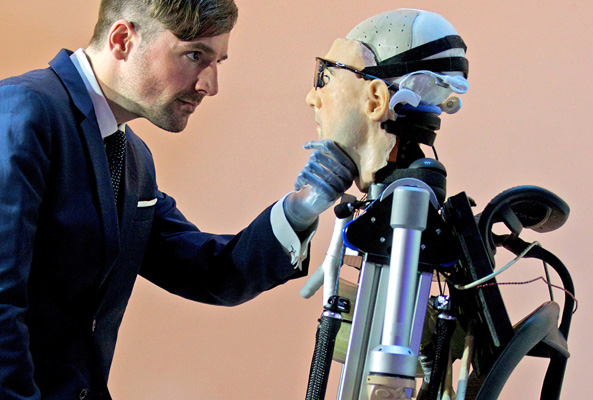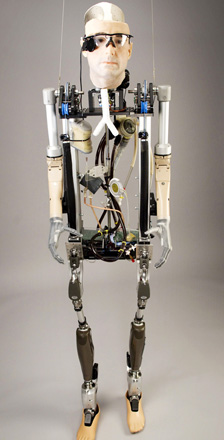 Rex’s face is modeled after a real man—Swiss psychologist Bertolt Meyer, above. (Andrew Cowie / AFP / Getty Images)
Rex’s face is modeled after a real man—Swiss psychologist Bertolt Meyer, above. (Andrew Cowie / AFP / Getty Images)
A Realistic Robot
Scientists have built a humanoid robot with working organs

Rex has a robotic kidney, pancreas, and spleen, and even a battery-operated heart. (Rex Features via AP Images)
He has the face of a man, is six feet tall, and has working organs, hands, and feet. His name is Rex—but he is not a human. Rex is a robot, and he is the world’s most complete and high-tech bionic man to date.
Something that is bionic has prosthetic (artificial or human-made) parts. Rex is made out of many body parts built by scientists from all over the world. He made his debut earlier this month at the London Science Museum, where he is currently on display. Rex can see, walk, and talk using artificial intelligence. His face is modeled after that of a real man—Swiss psychologist Bertolt Meyer.
Rex is also known as the Million-Dollar Man, because that’s how much it cost to build him. A number of different systems control his many body functions. Rex’s hands are controlled through electrical signals generated by his arm muscles. His legs use a motor-and-spring system that mimics human motion. His glasses help his fake eyes to “see”: They send images to a microchip in his eyes, which then send electrical impulses to Rex’s artificial brain to identify shapes and patterns.
Rex’s internal organs are just as technologically advanced. He has a bionic kidney and pancreas, an artificial spleen, and a battery-operated heart that pumps his fake blood.
BUILDING BODY PARTS
Rex was created to showcase advances in the creation of artificial body parts. Scientists have already learned how to build copies of the heart, lungs, eyes, and many other parts. These parts could one day be implanted in people who need them.
One organ that scientists have not yet been able to replicate is the human brain. Made up of roughly 100 billion neurons, it is the most complex known structure. For now, scientists are working to develop microchips that could someday work with real brains to treat brain diseases.
Some people think this new technology may not be such a good thing. They fear that artificial body parts could be made to work better than the real ones and that human abilities should not be improved upon. But Meyer says that this possibility is very far off. He points out that Rex walks very slowly and has limited abilities.
“[Rex],” he says, “shows how far away we still are from real bionic beings.”
Rex will remain at the London Science Museum until this summer, when he will travel to the United States.





